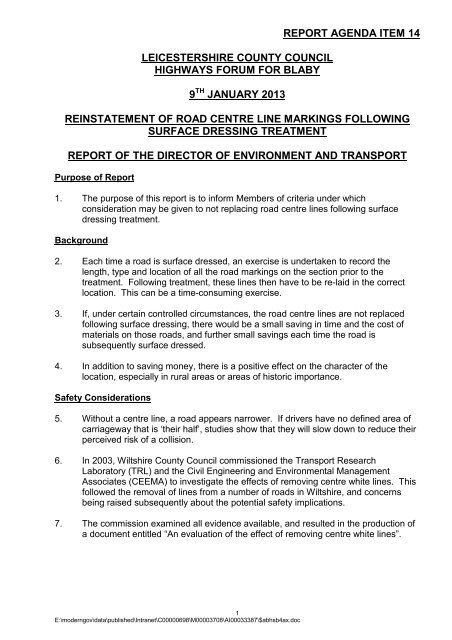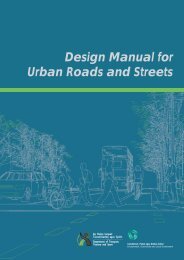Reinstatement of road centreline markings following surface dressing treatment
Reinstatement of road centreline markings following surface dressing treatment
Reinstatement of road centreline markings following surface dressing treatment
- No tags were found...
Create successful ePaper yourself
Turn your PDF publications into a flip-book with our unique Google optimized e-Paper software.
LEICESTERSHIRE COUNTY COUNCILHIGHWAYS FORUM FOR BLABY9 TH JANUARY 2013REPORT AGENDA ITEM 14REINSTATEMENT OF ROAD CENTRE LINE MARKINGS FOLLOWINGSURFACE DRESSING TREATMENTREPORT OF THE DIRECTOR OF ENVIRONMENT AND TRANSPORTPurpose <strong>of</strong> Report1. The purpose <strong>of</strong> this report is to inform Members <strong>of</strong> criteria under whichconsideration may be given to not replacing <strong>road</strong> centre lines <strong>following</strong> <strong>surface</strong><strong>dressing</strong> <strong>treatment</strong>.Background2. Each time a <strong>road</strong> is <strong>surface</strong> dressed, an exercise is undertaken to record thelength, type and location <strong>of</strong> all the <strong>road</strong> <strong>markings</strong> on the section prior to the<strong>treatment</strong>. Following <strong>treatment</strong>, these lines then have to be re-laid in the correctlocation. This can be a time-consuming exercise.3. If, under certain controlled circumstances, the <strong>road</strong> centre lines are not replaced<strong>following</strong> <strong>surface</strong> <strong>dressing</strong>, there would be a small saving in time and the cost <strong>of</strong>materials on those <strong>road</strong>s, and further small savings each time the <strong>road</strong> issubsequently <strong>surface</strong> dressed.4. In addition to saving money, there is a positive effect on the character <strong>of</strong> thelocation, especially in rural areas or areas <strong>of</strong> historic importance.Safety Considerations5. Without a centre line, a <strong>road</strong> appears narrower. If drivers have no defined area <strong>of</strong>carriageway that is ‘their half’, studies show that they will slow down to reduce theirperceived risk <strong>of</strong> a collision.6. In 2003, Wiltshire County Council commissioned the Transport ResearchLaboratory (TRL) and the Civil Engineering and Environmental ManagementAssociates (CEEMA) to investigate the effects <strong>of</strong> removing centre white lines. Thisfollowed the removal <strong>of</strong> lines from a number <strong>of</strong> <strong>road</strong>s in Wiltshire, and concernsbeing raised subsequently about the potential safety implications.7. The commission examined all evidence available, and resulted in the production <strong>of</strong>a document entitled “An evaluation <strong>of</strong> the effect <strong>of</strong> removing centre white lines”.1E:\moderngov\data\published\Intranet\C00000698\M00003708\AI00033387\$abhsb4ax.doc
8. The document reached the conclusion that, in the absence <strong>of</strong> a white centre line,uncertainty is created which encourages drivers to reduce their speed. Specifically,the evidence showed that drivers• Travel closer to the kerb-line• Adopt a more stable lateral position on the <strong>road</strong>• Have a 40% increase in lateral separation from oncoming traffic• Reduce their speed when they are close to oncoming vehicles• Travel marginally slower when they are close to oncoming vehicles comparedto drivers on a <strong>road</strong> with a centre line9. Significantly, the Wiltshire experiments also produced a 35% reduction in accidentrate.Criteria10. Before the non-replacement <strong>of</strong> any section <strong>of</strong> centre line is considered, the <strong>road</strong>must meet a set <strong>of</strong> criteria that assess its suitability. The <strong>road</strong> must:• not be an A or B classification(A and B <strong>road</strong>s form the strategic <strong>road</strong> network <strong>of</strong> Leicestershire, so theremoval <strong>of</strong> centre lines would not normally be appropriate)• be in a village or village-like setting(this provides the greatest benefit in terms <strong>of</strong> speed reduction andimprovement <strong>of</strong> the rural environment)11. Other factors that must be considered on a site-by-site basis are:• Road width – if a <strong>road</strong> is, or appears to be, very wide, the removal <strong>of</strong>lines may have an adverse effect as speeds may increase• Carriageway construction – if the carriageway is ‘un-restrained’, i.e. ithas no kerbs, consideration must be given to the potential adverseeffect <strong>of</strong> extra wear on the haunches and subsequent increasedmaintenance which would negate the cost savings <strong>of</strong> not replacing acentre line. In some instances, it may prove cost effective to replace (oradd) just edge <strong>markings</strong> in order to reduce speeds and protect thehaunches.• Street lighting – if street lighting is present, whether it will cause asignificant difference to the evaluation <strong>of</strong> the site if it is subsequentlyswitched <strong>of</strong>f. If street lighting is not present whether removing the<strong>centreline</strong>s may cause a hazard• Fog – if the proposed location is in a known fog-prone area then liningcould be essential to safe movement <strong>of</strong> vehicles12. Lines will not be removed in the vicinity <strong>of</strong> a hazard, such as a bend or junction.Procedure13. Once a location is considered suitable using the above criteria, the <strong>following</strong> will beundertaken:• the collection <strong>of</strong> all relevant information prior to any work (speed <strong>of</strong>traffic, location <strong>of</strong> all existing <strong>road</strong> <strong>markings</strong> etc.).2E:\moderngov\data\published\Intranet\C00000698\M00003708\AI00033387\$abhsb4ax.doc
• the gathering <strong>of</strong> accident data over an area extending several hundredmetres beyond the boundary <strong>of</strong> the proposed removal. If there havebeen any accidents in the area, they will be analysed by the accidentinvestigation team in order to ascertain whether the removal <strong>of</strong> thecentre line may have a positive or negative effect.• the consideration <strong>of</strong> pedestrian and vehicle safety, environmental andcost benefits <strong>of</strong> changing the <strong>markings</strong> and the possible need for furthersigning14. Once a site is confirmed as suitable, notifications will be sent to the parish anddistrict councils (as appropriate), the local County Councillor, the police and anyother stakeholders.15. Following completion <strong>of</strong> the work, the <strong>road</strong> will be monitored to assess any changesto vehicle speed and accident rates.Financial Appraisal16. If a <strong>road</strong> is to be considered for the non-reinstatement <strong>of</strong> its centre lines, there willbe initial work required to assess the potential site and carry out the necessarynotifications. This may cost more than the work normally required to ensure thereinstatement <strong>of</strong> the lining ‘as is’. However, there would be a subsequent reductionin costs each time the <strong>road</strong> is <strong>surface</strong> dressed and also a reduction in maintenancecosts due to there being less lining.17. There is therefore not a significant financial saving to be made by not replacing<strong>road</strong> centre lines <strong>following</strong> <strong>surface</strong> <strong>dressing</strong>.Environmental Appraisal18. By not replacing centre lines <strong>following</strong> <strong>surface</strong> <strong>dressing</strong>, there is a positive effect onthe character <strong>of</strong> the location, especially in rural areas or areas <strong>of</strong> historicimportance.19. Whilst not affecting the physical landscape, the removal <strong>of</strong> centre lines contributesto the spirit <strong>of</strong> the Government’s request to remove unnecessary ‘street clutter’.Legal Implications20. All lines on the highway must conform to the traffic signs regulations and generaldirections, but this states the standard to be adopted only if the highway authoritydecides that <strong>markings</strong> are appropriate for that location.21. Road centre lines, even where used, are not subject to a traffic regulation order.Therefore, there are no legal implications <strong>of</strong> a decision to consider the removal <strong>of</strong><strong>road</strong> centre lines at carefully selected locations.Other Implications22. As the initial work involved at each potential site is over and above the normalworkload <strong>of</strong> traffic management and accident investigation staff, it is not possible tocommit to a significant program <strong>of</strong> work. It is proposed that sites are tackled on the3E:\moderngov\data\published\Intranet\C00000698\M00003708\AI00033387\$abhsb4ax.doc
asis <strong>of</strong> a limited number per year so the extra work can fit in with othercommitments.Current Position in Leicestershire23. Centre lines have already been removed in a few locations in Leicestershire. Thishas normally been as a result <strong>of</strong> an improvement scheme or accident investigation,rather than for a saving in maintenance costs.24. There are currently 10 recorded locations in the County which previously hadcentre lines but now do not. These locations vary in length between 100 and 1000metres. Eight have a 30mph speed limit and two have a 20mph limit. The sites arelisted below:Village Road Route Length Speed Linesnumber (m) limit removedKilby Main Street C4502 550 20 2001Oadby Knighton Grange Unclassified 550 30 2006RoadQueniborough Main Street C4303 230 30 2007Sharnford Leicester Road B4114 100 30 2009Sileby Cossington Road C5213 800 30 2006Sileby Seagrave Road C5208 1000 30 May 2008Sileby Ratcliffe Road C5216 500 30 Jun 2009Stoughton Gaulby Lane C3403 and 300 20 2003C3401Syston Barkby Lane C3301 300 30 May 2008Thrussington Rearsby Road C5302 200 30 May 200925. As can be seen, the centre lines have been removed at various times, with oneremoval dating back almost 10 years. All these sites have had their recent accidentrecords inspected. Since the removal <strong>of</strong> the centre lines, there have been no injuryaccidents recorded on any <strong>of</strong> the stretches listed that could in any way beattributable to the removal <strong>of</strong> centre lines.26. Leicestershire Constabulary has confirmed that its <strong>of</strong>ficers are not aware <strong>of</strong> anyincidents relating to the removal <strong>of</strong> the lines.Recommendation27. Members are asked to note the contents <strong>of</strong> this report.Officer to ContactDavid Wright Tel: (0116) 305 5080Email: david.wright@leics.gov.ukBackground PapersNone.4E:\moderngov\data\published\Intranet\C00000698\M00003708\AI00033387\$abhsb4ax.doc




